The iPhone 4 Redux: Analyzing Apple's iOS 4.0.1 Signal Fix & Antenna Issue
by Brian Klug & Anand Lal Shimpi on July 15, 2010 12:28 PM EST- Posted in
- Smartphones
- Apple
- iOS 4
- iPhone 4
- Mobile
In case you haven’t noticed, the iPhone 4’s antenna design has come under considerable scrutiny. In our iPhone 4 review, we investigated the iPhone 4 antenna and came to two conclusions. First, that iOS 4 was displaying signal bars in an overly optimistic manner, compressing the dynamic range of possible signal bars users can see. Second, we identified a worst case signal drop of around 24 dB when the iPhone 4 is cupped tightly in the left hand, covering the black strip and possibly detuning the antennas and adding additional attenuation from the presence of the hand.
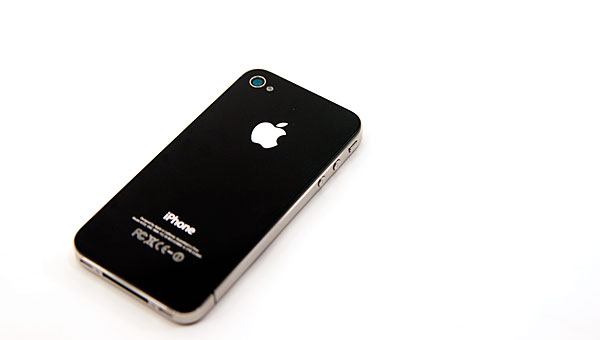
Since those initial measurements, we’ve been working tirelessly to both characterize the problem, fully understand the mechanisms behind it, and report on a number of possible solutions.
The Bars Have Changed
On July 2, Apple released a letter noting that the formula used in iOS 4.0 to calculate how many bars are presented for each signal strength is “totally wrong.” This mirrored our conclusions that the effects of the signal drop were exacerbated in part by the way the iPhone visualizes signal strength - the dynamic range is compressed so much that the 24 dB drop from cupping the phone without a case could make all the bars go away.
They went on to promise that in a future software update they would make bars 1, 2, and 3 taller, and make the bars more “accurate” by displaying 2 bars fewer in certain circumstances.
iOS 4.1 beta rolled around yesterday, and we immediately dove in to find out just how much the bar to signal strength mapping has changed. Update: iOS 4.0.1 final just came out this afternoon and we finished preliminary testing. The signal strength mapping algorithms are identical to the 4.1 beta. The findings in this article apply to 4.0.1 as well as the 4.1 beta.

After updating our devices to the iOS 4.1 beta (and 4.0.1) and making sure our little trick to show signal strength in dBm instead of bars still worked, we set off. Remember last time how I said I drove around town all day with iOS 4.0, testing the phone, and recording signal strength and how many bars were being shown? You guessed it - another update, another evening of driving around. Anand and I did quite our fair share of moving around to get a complete picture of what the new cutoffs are.
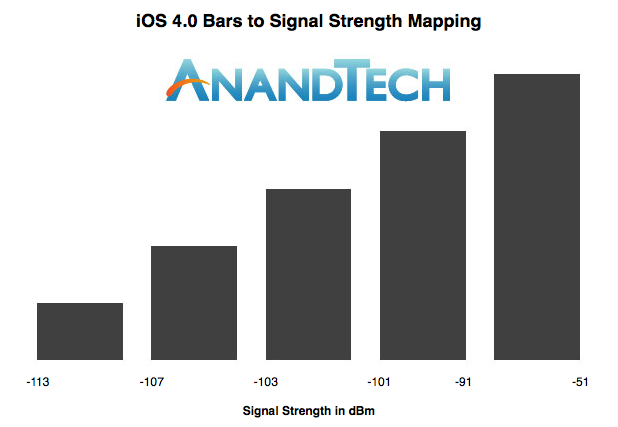
Old Bars
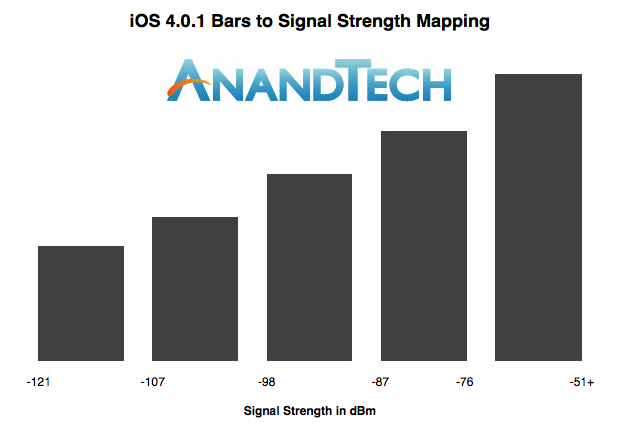
New Bars
The results are conclusive - Apple has dramatically changed the signal strength to signal bar mapping in iOS 4.0.1 and the iOS 4.1 beta, making the dynamic range not only much broader, but the range values for each bar much wider. The range of signals that correspond to bars three and four are the same width, and bar two is only slightly less.
The cutoff value for two bars to one bar remains the same, but every other value has increased. The result is that the worst case drop of 24 dBm no longer makes all the signal bars disappear, but rather two.
AnandTech reader Mike Escoffery, Director of Design and User Experience at Media Platforms, created his own diagram to help compare the old and new way of iOS signal strength reporting:
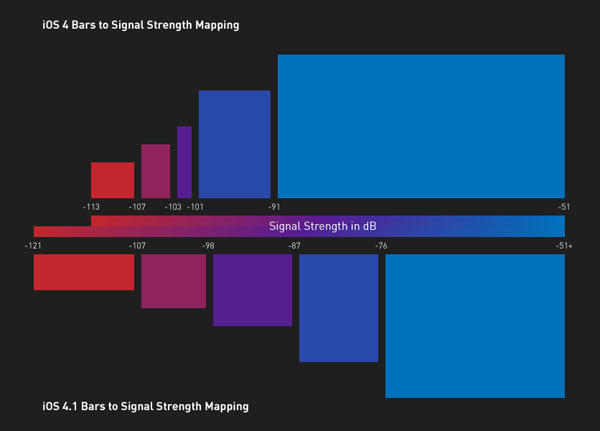
As you can see the old way (top) put far too much weight into the 5th bar of signal. Apple's new approach not only splits it up more reasonably between the 4th and 5th bar (still non-linearly keeping you in the 5th bar if possible) but also extends the range of the lower bars.
This change actually presented itself in our numeric signal strength reports - there’s more dynamic range in these numbers too. Previously, the absolute lowest value any iPhone would report was -113 dBm. With iOS 4.0.1/4.1, the value is now a shockingly low -121 dBm. In the iPhone 4 review, I talked a lot about how although the phone is prone to dropping signal from being held wrong, it was measurably more sensitive in weak signal areas. I was shocked that calls and data worked seemingly unfazed at -113 dBm. It seems as though this increased 8 dBm of range below -113 dBm was meant to show really how much more sensitive the radio stack is - it undeniably is more sensitive. Both Anand and I were able to hang onto calls all the way down at -121 dBm.
We’ve also included a comparison to how the latest version of Android displays signal bars from GSM or UMTS networks below. Thankfully, this didn’t require driving around town all day but rather inspecting the latest version of the Android source code from Google’s own repositories. Android uses an ASU value to compute signal strength, which isn’t anything more than a remapping of dBm to a sane value that’s a bit easier to interpret.
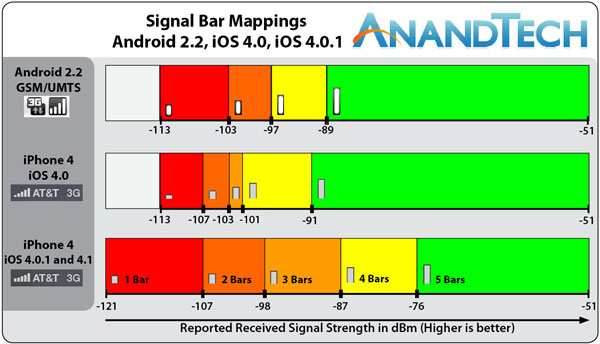
Apple’s mappings have gone from having probably the most compressed dynamic range among handset vendors to less compressed than Android.
While the software update obviously does not and cannot address the design of the antenna itself - or make the drop from holding the phone any less - it does change the way the issue is perceived among users. The result is that most iPhone users will see fewer bars disappear when they hold the iPhone 4 in a bare hand. The side effect is that the iPhone now displays fewer bars in most places, and users that haven’t been reporting signal in dBm will time see the - perhaps a bit shocking - reality of locations previously denoted as having excellent signal.
Interestingly enough, Apple has indeed changed the heights of bars 1, 2, and 3. They’re taller, and the result is that the relative heights are no longer linear, but rather a tad exponential looking. It’s a mind trick that Apple no doubt hopes will make the signal look better. If the bars are taller, they must denote stronger signal, right?
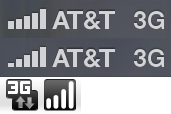
From top to bottom: iOS 4.1, iOS 4.0, Android 2.2
The reality is that Apple likely wants to deflect at least some of the initial backlash AT&T will face for reporting the signal bars without any concessions. Concessions that used to make coverage look better than it really is. Regardless of how tall the bars are, there are still going to be fewer of them virtually everywhere. Interestingly enough, while bars 1 and 2 are the most changed, their respective cutoffs are virtually unchanged.
While I was testing iOS 4.0.1, I told Anand that the signal reporting lie that started with the iPhone 3G had been removed entirely. That iOS 4.0.1 would potentially show the reality of AT&T’s coverage to iPhone users. With 4.0.1 users looking at signal bars will get a much more realistic view of how signal is changing.
We tested the iOS 4.1 beta on iPhone 3GSes as well, and found the mappings to be the same there as well.










146 Comments
View All Comments
bplewis24 - Friday, July 16, 2010 - link
Because it does not. Look up any number of videos on the subject: http://www.youtube.com/watch?v=F6oflC4qo8M&pla...eliotw - Friday, July 16, 2010 - link
Anand's results shown in this article seem to show otherwise. In the video you linked it's not too surprising that data rates would slow down as the iPhone adjusted for the sudden attenuation in signal strength. That "test" could have been better if they let the phone stabilize before attempting to load data. I don't question that signal attenuation is happening but based on the results here is seems like overall it's as good or better than the 3GS.ajb - Saturday, July 17, 2010 - link
It deserves an urgent fix because although it might be better in some situations (when it's on a desk and not being held or only lightly held with two fingers on the center edges of the phone) in many situations with a weak signal present just holding the phone normally can attenuate the signal enough to drop the call. Based on my own experience, you don't need anywhere near a "death grip" to drop a call in such situations. That's a real problem and Apple is only paying it lip service. A free bumper, even though it would likely solve the problem, is far short of a fix for a phone that has been marketed as the thinest coolest phone of all smartphones. Many people, me included, don't want to have to put a bumper on the phone. I bought an Invisishield to protect the phone ($30 for front and back, plus $13 for Best Buy to install) for the specific reason of not having to put the phone in a case!aj28 - Thursday, July 15, 2010 - link
This whole thing is ridiculous. You know what else doesn't work well when tightly cupped in your left hand? Asymmetrical mice.geogaddi - Friday, July 16, 2010 - link
i can think of at least one other thing that doesn't work well when cupped tightly in my left hand...Snaafu - Thursday, July 15, 2010 - link
Thanks for the information and work you guys put into getting the information out to us. Brand doesn't matter to me, keep reviewing Apple and all the others!!logicbus - Thursday, July 15, 2010 - link
FTA: "The range of signals that correspond to bars three and four are the same width, and bar two is only slightly less."I had to read this sentence a few times. At first, I thought it meant that that bars three and four are the same width -- as they were in iOS 4.0 -- and that bar two is only slightly less [wide] -- than it was in iOS 4.0.
After the re-reads I concluded that the authors meant that in 4.0.1, bars two, three, and four are now all roughly the same width as each other, whereas in 4.0, they were less consistent. Maybe the language should be updated to make this more clear.
sthaznpride17 - Thursday, July 15, 2010 - link
Wow at the people saying Anand is biased towards Apple. Seriously, read Engadget or Tech Crunch's MG Siegler articles if you want to know who really kisses Steve Jobs' ass. Anandtech and Arstechnica have provided the best coverage regarding the iPhone 4 and have by far the most objective articles out of any tech site I have been to. Props to these guys for not being shills for Apple or any other company for that matter.MrBrownSound - Thursday, July 15, 2010 - link
Bigger bars = better network indeedshchoy - Friday, July 16, 2010 - link
A solid article. This is exactly the reason why I keep coming back to Anandtech for good tech reads.